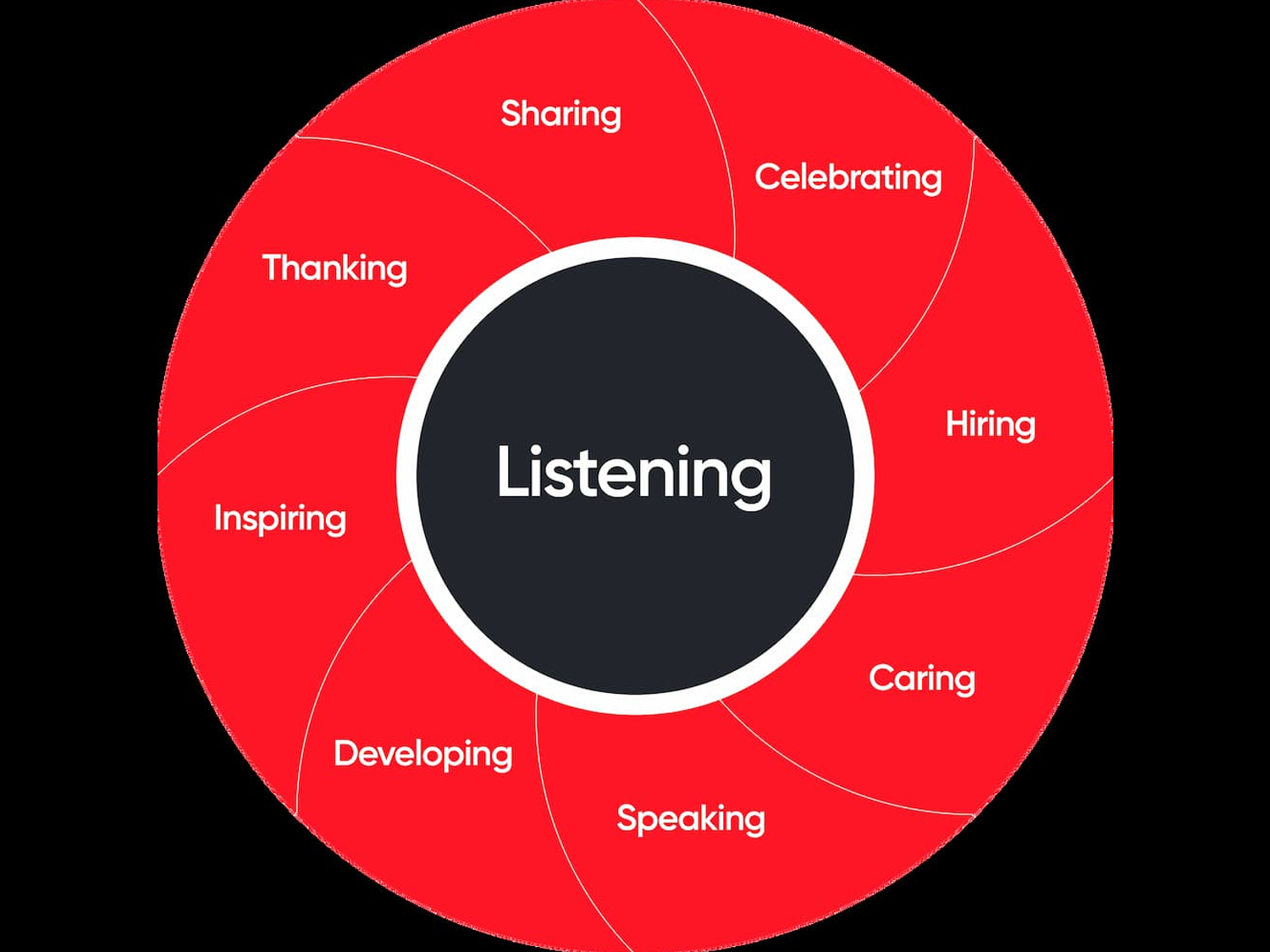Caring , High-trust leadership, Leadership & Management
Caring — one of the nine high-trust leadership behaviors — happens when leaders take time to learn about employees’ lives beyond the workplace and invest in their success.
Whether or not he ever actually said it, Theodore Roosevelt’s apocryphal quote still applies to today’s workplace: “Nobody cares how much you know until they know how much you care.”
When leaders demonstrate a high level of care, it unlocks employee performance.
“People care about their work when they experience being cared for,” says Michael C. Bush, CEO of Great Place To Work®. “That shows up when you take time to understand and listen to people’s experiences, inside and outside of work.”
One of the nine high-trust leadership behaviors, caring is a signal to employees that leaders are invested in their lives and well-being, not just their performance on the job.
It’s not enough to want everyone in the organization to achieve professional success and earn accolades for their work. Do you also care about what it cost them to deliver that success?
Leaders that demonstrate a high level of care for employees ask questions about workload and work-life balance. They are focused on creating inclusive and welcoming environments where everyone can have a sense they belong. They prioritize employee well-being and take the time to learn about each individual employee’s goals and needs.
In this way, leaders might rewrite Roosevelt’s aphorism: The more you know about someone, the more you will care about them.
Here’s how great workplaces strive to ensure employees have managers who lead with empathy and build inclusive environments where everyone can succeed:
1. Offer flexibility for employees navigating complex lives outside of work
Great Place To Work research has found that when employees can choose where they work, they are:
- Three times more likely to want to stay at the company
- 14 times less likely to “quit and stay”
That doesn’t mean that every workplace builds a better culture when employees can work from home. Instead, the data highlights the value employees put on flexibility.
There are many ways to offer flexibility to employees. PCL Construction offers rotating weekend project schedules to allow workers to flex their time and participate in important family activities.
Sheetz, a convenience store chain, revamped schedules to ensure full-time management employees have a consistent schedule with two back-to-back days off and flexibility around when they start or finish a shift.
Great workplaces also ensure that when life events occur, employees have the space they need. At Baird, the company makes exceptions to its policies to meet the individual needs of an employee, whether that is offering three months of paid leave to an associate who lost a spouse, or offering four weeks of paid time off to an associate to care for family members with acute medical needs.
In the U.S., there isn’t a federal bereavement leave policy, with the average HR policy offering between one and five days.
Hilton, No. 1 on the 2024 Fortune 100 Best Companies to Work For® List, has made investments in supporting caregivers. After estimating that 80% of its workforce is impacted by caregiving responsibilities, the hotel chain launched a resource hub to connect employees with information and tools. It also partnered with Wellthy, a service that allows team members to find care services for children and aging parents.
2. Break down barriers to ensure everyone can thrive
When leaders care about employees, they investigate the barriers that might be holding people back. They consider how equitable the workplace is — looking to see if everyone regardless of role or background has the opportunity to grow and the ability to thrive.
Employee resource groups (ERGs) can be vital tools for building belonging and trust in the workplace. What really unlocks their power is ensuring that affinity groups have clear business goals, rather than getting sidelined as a networking group.
At Cadence, that meant asking women from its operations all over the world to come together and share ideas to improve business operations.
“We want to empower the women at Cadence to have a serious voice on policies, development, mentorship, and things that are business critical so we can hopefully move those areas in a way we wouldn’t be able to do without their voice,” Tina Jones, SVP of global human resources at Cadence shared on the “Better” podcast.
To understand the barriers that are preventing some employees from having a great experience, start with your data. Even better, disaggregate your data to get the full picture of how different experiences and backgrounds can intersect to create inequality for your workforce.
“None of us are one thing,” Brian K. Reaves, chief belonging, equity, and impact officer at UKG shared at the For All Summit™ in 2024. “The multiple layers of who we are sometimes leads to different outcomes for certain people than others.”
An example of this in practice is how Intuit developed its Trans+ Summit to support transgender and nonbinary employees in the workplace.
“By regularly checking in with our trans and nonbinary colleagues, we can make any necessary changes to ensure that they feel valued and supported in their work,” says Cecilia Persson-Ramos, DEI employee resource group leader at Intuit.
3. Invest in employee well-being
When employees don’t experience well-being — either from burnout, loneliness, or other factors — they won’t feel that leaders care about them.
A commitment to well-being requires companies to invest in leadership training and development. Research from UKG found that managers have greater impact on employees’ mental health than their therapist or doctor.
Great workplaces ensure that employees build connections with colleagues and have a regular one-on-one with their manager. At Cisco, managers also receive a toolkit with tips on how to effectively listen and respond to the needs of employees on their teams as part of its “Safe to Talk” program, which supports Cisco employees in navigating mental health issues at work.
Great workplaces also consider how overlooked or hidden health issues can create a poor experience for employees. AbbVie has made a goal to create a migraine-friendly workplace after identifying migraines as the second-most common disability condition in the world. To support employees who suffer from migraines, the global health tech company has launched resources to educate employees about the condition.
4. Consider your impact outside of the workplace
Great workplaces also think about their impact on the outside world. When companies truly care about employees, they also think about their families and the communities they live in.
At Nationwide, leaders learned that associates were increasingly concerned about the mental well-being of their children, with data showing that mental health challenges were on the rise during the COVID-19 pandemic.
Nationwide responded by funding the Bloom program, a set of resources created by behavioral experts at Nationwide Children’s Hospital in Columbus, Ohio. Nationwide associates were instrumental in developing and piloting the program, which was launched to external users in 2023.
At Sephora, digging into the results of its “Racial Bias in Retail” study revealed the need for broader action. After commissioning the study in 2019, the cosmetics company launched a multi-stakeholder collaboration with 42 U.S. retailer brands to reduce racially biased interactions from the customer experience.
Great workplaces don’t just care about employees when they are in an office or on a work site. Great workplaces care about the communities where employees live and are making investments to protect the planet.
This often requires looking at the bigger picture. At Hewlett Packard Enterprise, only 3% of its total carbon emissions comes from its own operations. Its supply chain is responsible for 31% and a whopping 66% is generated when customers use HPE’s products.
To make real change, HPE’s employees play a crucial role in educating customers and solving problems creatively. The company has tasked employees with not only thinking about sustainability within HPE, but also driving higher standards and better practices among consumers who use the company’s products.
Sales and pre-sales teams can earn a “sustainability badge” and serve as crucial conduits, ensuring that customers can use sustainability best practices through the entire customers lifecycle.
Benchmark your culture
Discover what employees value about working at your company and how you can boost retention rates and increase productivity and performance with Great Place To Work Certification™.











